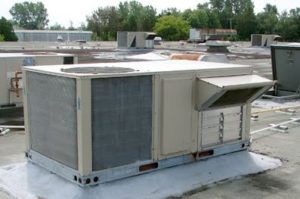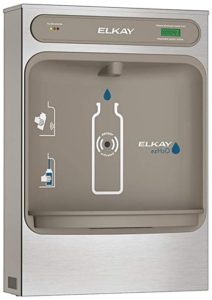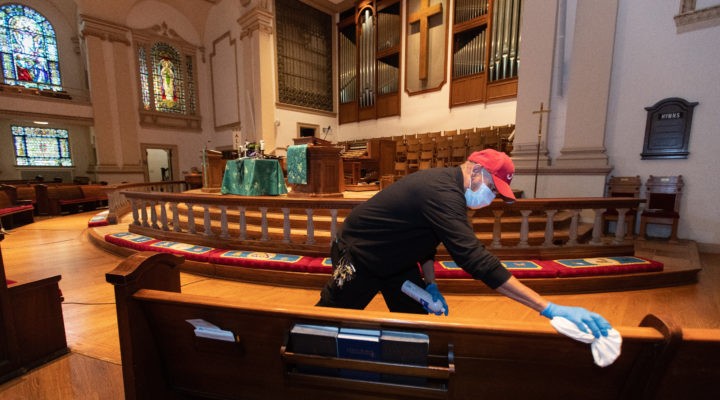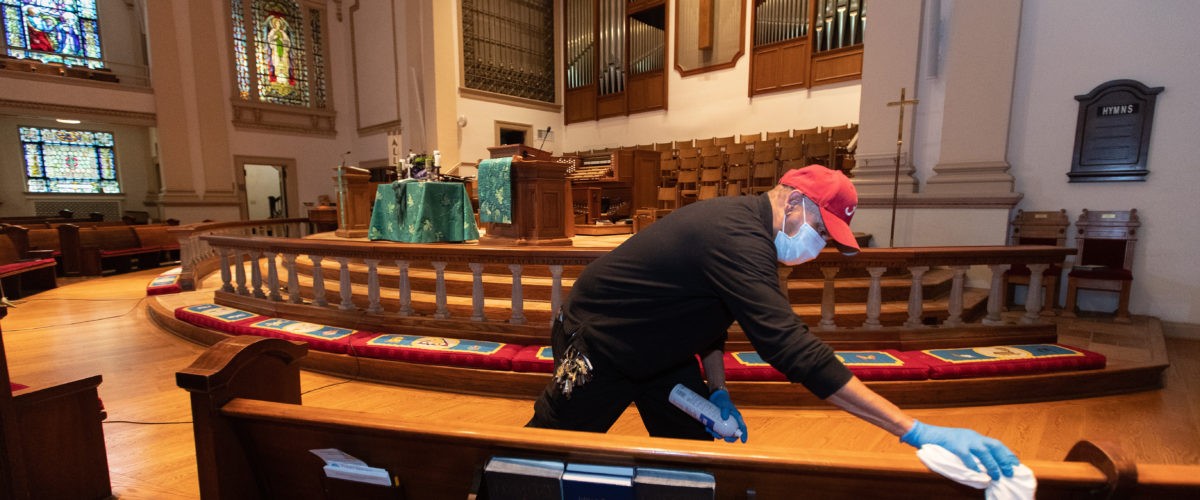Closing down church buildings could create serious repercussions not just for the people who miss gathering there but also for the facilities themselves.
Imagine walking into a house that has been shut up or abandoned for a period of time — the musty, dusty smell and the occasional surprise leak that has silently wreaked havoc. That could be the scene — or worse — in many a church shut down during the global pandemic, unless proper precautions are taken now, say church facilities management experts.
“When there’s nobody there, things go wrong and nobody knows things have gone wrong.”
And while penny-conscious church leaders may think they’re saving money by turning off the air conditioning, that decision alone could lead to thousands of dollars in unexpected expenses when the church reopens.
“Churches have got to cut expenses to match income, but at some level they have to recognize you can pay for some of that down the road if you haven’t taken proper care of your buildings,” said Randy Crosland, former facilities manager at Temple Emanu-El in Dallas, First Baptist Church of Richardson, Texas, and First United Methodist Church in Lubbock, Texas.
Crosland knows what it’s like to walk into a facility that has been locked up hastily or without proper precautions. A few years ago, the veteran church facilities manager became part of the crew rehabbing Glorieta Baptist Conference Center after the New Mexico camp was sold by LifeWay Christian Resources to a nonprofit called Glorieta 2.0.
“Buildings are like people,” he said. “They don’t do well when they’re sitting around doing nothing. When there’s nobody there, things go wrong and nobody knows things have gone wrong.”
A foreshadowing of things to come

Randy Crosland
He got a foreshadowing of his Glorieta work about 16 years ago when he helped an Eritrean Baptist church in Dallas take over the large facility of an Anglo congregation that had shut down and locked up its building.
“They had shut it down in good condition,” he recalled. “But it had gotten into terrible deterioration while no one was there.”
Normally, when a church building develops a small roof leak in a classroom, that will be reported to the facilities manager and can be repaired for a few hundred dollars, he explained. “But if nobody is going in those rooms for weeks or months, a small leak can quickly get out of control and create thousands of dollars of expense.”
Or, he added: “What if a plumbing fixture in a bathroom breaks and floods the building while no one is there?”
Even an average size church can have a lot of square footage under roof due to the nature of churches with classrooms, offices, worship spaces and activity spaces. Crosland cited one large Baptist church he knows that cares for 1 million square feet of indoor space.
“You have to have people who are assigned to walk those buildings at least every couple of days,” he advised. “Every restroom, every room — just walk around and see what it looks like.”
Don’t exclude church facilities staff
The global pandemic is not the right time to lay off or furlough facilities staff, added Patrick Hart, director of facilities at Northshore Christian Church in Everett, Wash., and executive director of the National Association of Church Facilities Managers. Yet he knows of churches that have done just that, locking up their buildings and sending staff home.

Patrick Hart
One of his association’s members not only was sent home but was forbidden from entering the building for any reason. The man became so frustrated, knowing the damage that likely was happening inside the building, that he resigned and took another job.
“If you are a church with a facilities manager and you’ve not included them in the conversation about COVID and post-COVID, you’ve missed an opportunity,” he advised.
And churches without professional facilities managers should assign someone or some team of members to serve as caretakers of the building during the shutdown.
“Five months is a long time,” he said. “We’ve already crossed two seasons, for us in Seattle a rainy spring and now summer heat. My encouragement to churches would be to get in there and at least have someone looking at your facilities during this interim so that when it’s safe to come back you don’t have to delay it further due to unexpected repairs.”
Crosland agreed: “Churches need to be sure that somebody who has some maintenance knowledge is kept on and is up there every day, coming into that building and walking that building. They need to be sure everything is fine. Maybe have a notebook with you or use your phone to record what you see.”
Keep the air flowing
One of the most important considerations for any church building not being used as it normally would is HVAC systems, both Crosland and Hart agreed.
“When you shut them down and don’t turn them on, you save a lot of money in electricity or gas, but the systems don’t do well,” Crosland said. “Maybe rather than turning it off completely just raise thermostat set points to mid-80s for air conditioning or in heating mode mid-50s, but let it keep running and keep the air circulating.”
There are several reasons for this, including the overall benefit to the building of having air moving and the fact that HVAC equipment is designed to run, not to sit idle. “In air-conditioning systems, if they don’t run at all, seals dry up and crack and you lose freon,” he said.
And that’s only the beginning of the conversation church leaders need to have about HVAC, Hart added.
 Many church buildings are cooled by packaged rooftop units, individual air conditioning units that sit unseen on roofs and serve smaller sections of a building. “If you shut them down, you may have things go wrong,” Hart said. “Seals break. You get bad air quality, and then you’ll need to change filters.”
Many church buildings are cooled by packaged rooftop units, individual air conditioning units that sit unseen on roofs and serve smaller sections of a building. “If you shut them down, you may have things go wrong,” Hart said. “Seals break. You get bad air quality, and then you’ll need to change filters.”
He paused and noted that air filters should be an important topic of conversation for all churches in a COVID and post-COVID world. A primary question is whether to change to a heavier grade of filter that will screen out more germs. But that decision cannot be made in isolation, because not all HVAC units can handle the heavier filters that create less air flow and will therefore burn out motors.
Another important consideration for preventing the spread of airborne germs is to evaluate the mix of fresh air and recirculated air coming back into the church, Hart advised. While 100% fresh air might be best, that may not be practical in certain climates with high humidity. What works for him in the Pacific Northwest — where he draws 100% airflow from outside — would never work in the South, he said.
And then there’s a more practical question to add to this mix, he suggested: “Many of our association members are installing things in their HVAC equipment that kills the virus, but if masks work and 6-feet distance works, why do I need to update my HVAC?”
Imagine 700 toilets
Most church members don’t realize the number of mechanical units of all kinds that operate daily in most churches, Crosland said. He lived through an extreme example of this at Glorieta, where there are 700 toilets on campus.
Even in normal times at Glorieta — which always has operated at its peak in the summer months — buildings were winterized in the off-season. That meant shutting off the water and draining every toilet and shower drain to prevent freezing.
Such winterizing may not be on the radar of church leaders in August, but if church facilities remain closed into the fall and winter, winterizing should be high on the list of precautions taken, he said.
Checklist
Here is a list of other areas where church leadership should pay attention during the current COVID-19 shutdown:

(Bigstockphoto)
Trap drains. “Anything that has a trap drain will dry out,” Hart said. “If a sink isn’t used, you’ve got to put water in it, or you’ll come in and be blocked out by sewer fumes. The same is true with floor drains, which most people forget about.”
Outdoor irrigation systems. When properly staffed, churches with irrigation systems on their lawns won’t think twice about these systems. But if the facilities manager or other person who normally handles the lawn has been furloughed or released, someone else needs to think about how to prevent freezing.
Roof maintenance. Again, an ounce of prevention is worth a pound of cure. Not inspecting roofs, not walking through every part of a building looking for leaks can turn a simple fix into a disaster in a few hours or days.
Exterior repair. Normally, people are walking around the entire perimeter of most church buildings and will notice when a brick is loose or wooden siding has begun to rot. Left unnoticed, however, small exterior holes that could be repaired in minutes can lead to major projects that take weeks and thousands of dollars.
Kitchens. If the church kitchen has been shut down, decisions need to be made about stoves, ovens, refrigerators and freezers. If no one will be around on a regular basis, it would be best to shut off gas service to ovens and stoves at the main shutoff, not just in the kitchen itself, Crosland said. “If you had a gas leak and didn’t know it, you could raise the roof of the church unintentionally.”
Likewise, all refrigeration equipment should be cleaned out, washed down and dried. If possible, leave refrigerators and freezers running, because they will wear better that way, Crosland said. However, if such equipment must be turned off, be sure it has been cleaned out and left with the doors propped open.
“It is amazing that people will leave stuff in even commercial refrigerators. Clean them out. Don’t leave anything in there. Even deep freezes. There’s no way to know if power has gone out while you’re away, so it’s just better to get rid of all food. Donate it the food bank or find out who in your congregation needs it.”
Pipe organs. “Do not winterize a sanctuary with a pipe organ,” Crosland said. “It’s not good for a pipe organ to get that cold. Organ manufacturers always want you to keep a constant temperature in a sanctuary, with humidity and temperature as constant as possible.”
The financial constraints of the present time may make it unfeasible to run the air in a church’s sanctuary on a normal schedule just for the sake of the organ, but it’s likely a compromise position could be found, he added.
Think ahead while buildings are closed
Finally, church leaders should think proactively right now and tackle deferred maintenance and renovation projects while their buildings are virtually empty, Hart advised.
He reported about 90% of his organization’s member churches are using the downtime to make improvements or renovations to facilities. “Everybody’s been painting and cleaning carpet.”
Beyond that, churches are sprucing up restrooms and adding touch-free equipment. “A lot of churches have converted their sinks, soap dispensers, hand towels, water fountains. This is a great idea.”
 One such area that could be easily overlooked is water fountains, he added. “We have bottle-fill features built into our water fountains.”
One such area that could be easily overlooked is water fountains, he added. “We have bottle-fill features built into our water fountains.”
Church leaders who want to know how to prepare to reopen should go visit their local indoor shopping mall, Hart said. “Go visit the local mall and take photos of all their signage. They’re doing it right.”
And this one last word of advice from Hart, whose church has begun opening for in-person worship on a limited basis: Start looking for hand sanitizer now.
“We still can’t get it,” he said, noting the church invested in automated dispensers but can’t get refills. “They’re all on backorder.”


